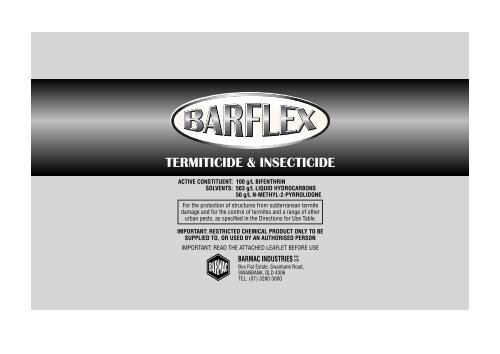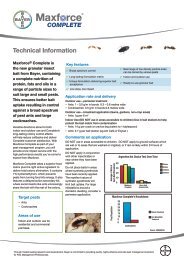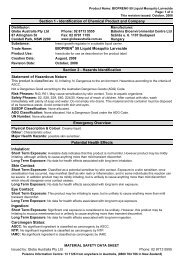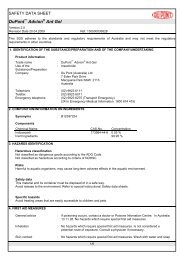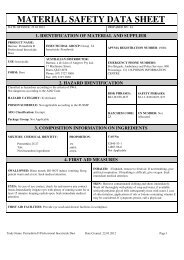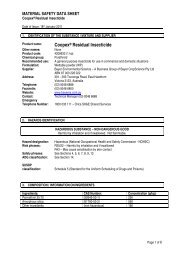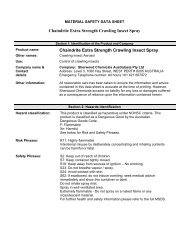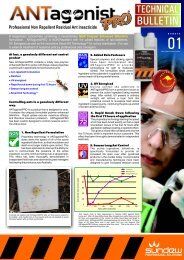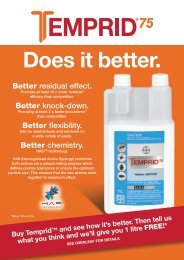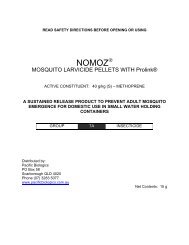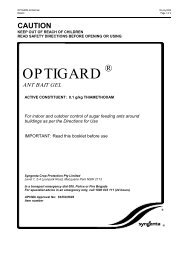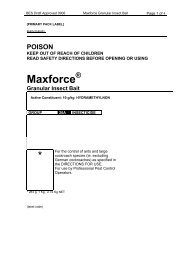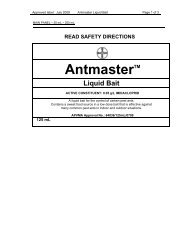Label - Globe Australia
Label - Globe Australia
Label - Globe Australia
You also want an ePaper? Increase the reach of your titles
YUMPU automatically turns print PDFs into web optimized ePapers that Google loves.
TERMITICIDE & INSECTICIDE<br />
ACTIVE CONSTITUENT: 100 g/L BIFENTHRIN<br />
SOLVENTS: 563 g/L LIQUID HYDROCARBONS<br />
50 g/L N-METHYL-2-PYRROLIDONE<br />
For the protection of structures from subterranean termite<br />
damage and for the control of termites and a range of other<br />
urban pests, as specified in the Directions for Use Table.<br />
IMPORTANT: RESTRICTED CHEMICAL PRODUCT ONLY TO BE<br />
SUPPLIED TO, OR USED BY AN AUTHORISED PERSON<br />
IMPORTANT: READ THE ATTACHED LEAFLET BEFORE USE<br />
BARMAC INDUSTRIES PTY<br />
LTD<br />
Box Flat Estate, Swanbank Road,<br />
SWANBANK, QLD 4306<br />
TEL: (07) 3280 3000
Barflex Termiticide & Insecticide<br />
DIRECTIONS FOR USE<br />
Restraints:<br />
Do NOT use this product at less than indicated label rates.<br />
Do NOT apply to soils if excessively wet or immediately after heavy rain to avoid run-off of the chemical.<br />
Do NOT use in cavity walls (except via certified cavity infill reticulation systems or direct treatment of nest).<br />
Pest Situations State Rate Critical Comments<br />
Spiders<br />
Papernest Wasps<br />
Ants, Cockroaches,<br />
Mosquitoes, Fleas,<br />
Flies, Ticks (excluding<br />
the paralysis tick<br />
Ixodes holocyclus)<br />
(Adults & Nymphs)<br />
Subterranean Termites<br />
External Areas & Surrounds of<br />
Domestic, Commercial, Public<br />
& Industrial buildings and<br />
structures<br />
External Areas & Surrounds of<br />
Domestic, Commercial, Public<br />
& Industrial buildings and<br />
structures<br />
External Areas & Surrounds of<br />
Domestic, Commercial, Public<br />
& Industrial buildings and<br />
structures<br />
Domestic, Public, Commercial &<br />
Industrial areas<br />
All states 25-50 mL/10L Use the higher rate in situations where pest pressure is high, when rapid knockdown and/or maximum residual<br />
protection is desired. Pay particular attention to protected dark areas such as cracks and crevices, under floors,<br />
eaves and other known hiding or resting places. For overall band surface spray, apply as a course, low pressure<br />
surface spray to areas where spiders hide, frequent and rest. Spray to the point of run-off using around 5L of spray<br />
mixture per 100m² and ensuring thorough coverage of the treated surfaces.<br />
For crack and crevice treatment use an appropriate solid stream nozzle.<br />
For maximum spider control use a two part treatment.<br />
1. Crack and crevice.<br />
2. Overall band spray of surfaces.<br />
All states 50 mL/10L Apply prepared emulsion to the point of run-off directly to the papernest ensuring thorough and even coverage.<br />
When all adult wasps have been knocked-down the nest may be safely removed from the structure.<br />
All states 50-100 mL/10L On non-porous surfaces apply as a coarse spray at the rate of 1L of emulsion per 20m². When treating non-porous<br />
surfaces do not exceed the point of run-off.<br />
All states,<br />
except Tas<br />
Refer to Table A Refer to Table B.<br />
On porous surfaces or use through power equipment, spray at the rate of 1L of emulsion per 10m². When treating<br />
porous surfaces do not exceed the point of run-off.<br />
Use the higher rate in situations where pest pressure is high, when rapid knockdown and/or maximum residual<br />
protection is desired. The lower rate may be used for follow-up treatments.<br />
To control ants apply to trails and nests. Repeat as necessary.<br />
To control fleas and ticks apply prepared emulsion to outside surfaces of buildings and surrounds including but not<br />
limited to foundations, verandahs, window frames, eaves, patios, garages, pet housing, soil, turf, trunks of woody<br />
ornamentals or other areas where pests congregate or have been seen.<br />
To control flies and mosquitoes apply prepared emulsion to surfaces where insects rest or harbour. Re-apply as<br />
necessary.<br />
For perimeter treatments apply the prepared emulsion to a band of soil or vegetation two to three metres wide around<br />
and adjacent to the structure. Also spray volume of 5 to 10L per 100m². Higher volumes of water may be needed if<br />
organic matter is present or foliage is dense.
TABLE A: Barflex Termiticide & Insecticide use rates for control of SUBTERRANEAN TERMITES<br />
Situations<br />
Pre-Construction Barriers<br />
Under slabs and under suspended floors with less<br />
than 400mm crawl space<br />
Perimeter Barriers<br />
For new and existing buildings<br />
Post-Construction Barriers<br />
Under slabs and under suspended floors with less<br />
than 400 mm crawl space.<br />
All areas SOUTH of the<br />
Tropic of Capricorn (except Tas)<br />
All areas NORTH of the<br />
Tropic of Capricorn<br />
Rate Expected Protection Period* Rate Expected Protection Period*<br />
1 L/100L At least 10 years 1.5L/100L 5 years<br />
1 L/100L (Note 1) 4 years<br />
500 mL/100L 10 years 750 mL/100L (Note 1) 3 years<br />
500 mL/100L (Note 1) 2 years<br />
1 L/100L At least 10 years 1.5L/100L 5 years<br />
500 mL/100L 10 years 1 L/100L 4 years<br />
250 mL/100L 3 years 750 mL/100L 3 years<br />
500 mL/100L 2 years<br />
1 L/100L At least 10 years 1.5L/100L 5 years<br />
1 L/100L 4 years<br />
500 mL/100L 10 years 750 mL/100L 3 years<br />
500 mL/100L 2 years<br />
Reticulation systems 1 L/100L At least 10 years 1.5L/100L 5 years<br />
Perimeter and/or service penetration treatment only 500 mL/100L 10 years 1 L/100L 4 years<br />
Reticulation Systems<br />
Cavity infill & footing barriers<br />
250 mL/100L 3 years 750 mL/100L 3 years<br />
500 mL/100L 2 years<br />
500 mL/100L 5 years 1 L/100L 2 years<br />
Protection of Poles & Fence Posts 500 mL/100L 10 years 1.5L/100L 5 years<br />
1 L/100L 4 years<br />
750 mL/100L 3 years<br />
Nest Eradication 500 mL/100L Not applicable 500 mL/100L Not applicable<br />
Note 1: This rate must be used in conjunction with a certified reticulation system that is capable of distributing the Termiticide & Insecticide emulsion according to the product label and the <strong>Australia</strong>n Standard AS 3660 Series.<br />
* The need for retreatment is to be determined as a result of at least an annual inspection, or more frequently in high risk areas, by a qualified Pest Control Operator.<br />
The actual protection period will depend on the termite hazard, climate, soil conditions and rate of termiticide used.
TABLE B: CRITICAL COMMENTS for use against SUBTERRANEAN TERMITES<br />
Situations<br />
Pre-Construction Barriers<br />
Under Slabs for protection of new buildings<br />
Pre-Construction Barriers<br />
Under suspended floors<br />
Perimeter Barriers<br />
For new and existing buildings<br />
Post-Construction Barrier Treatments<br />
For the protection of existing buildings<br />
Reticulation Systems<br />
Perimeter and/or service penetration treatment<br />
only<br />
Critical Comments<br />
• Apply with suitable application equipment to form a complete and continuous chemical barrier (both vertical and horizontal) under the slab. The formation of the<br />
barrier may require a combination of conventional open wand application and soil trenching and/or rodding applications. Recommended rod spacing should be<br />
between 150 and 300 mm, as per soil type. For additional information refer to “CRITICAL APPLICATION DETAILS” on this label and the <strong>Australia</strong>n Standard AS 3660<br />
Series.<br />
• An external perimeter barrier (both horizontal and vertical) is an essential part of termite protection and must be installed at the completion of the building. Refer<br />
to “Perimeter Barriers” below, for further details.<br />
• Chemical barriers that have been disturbed by construction, excavation and/or landscaping activities will need to be reapplied to restore continuity of the barrier.<br />
• For areas beneath suspended floors that have inadequate access (eg, less than 400 mm clearance), the entire sub-floor area should be treated as a continuous<br />
horizontal barrier, which completely abuts an internal vertical barrier around any substructure walls. Ideally, this operation should be done during construction of<br />
the building while access is more readily available.<br />
• For areas beneath suspended floors which have adequate access (eg, more than 400 mm clearance), install perimeter barriers around each individual pier, stump,<br />
service penetration and substructure walls.<br />
• An external perimeter barrier (both horizontal and vertical) is an essential part of termite protection and must be installed at the completion of the building. Refer<br />
to “Perimeter Barriers” in this leaflet, for further details.<br />
• Perimeter barriers (both horizontal and vertical, external and where required, internal or sub-floor) are an essential part of termite protection and must be installed<br />
at the completion of the building. Perimeter barriers should be installed around slabs, piers, substructure walls and external penetration points.<br />
• Apply with suitable application equipment to form a continuous chemical barrier (both vertical and horizontal) around the structure and to a depth reaching 80 mm<br />
below the top of the footings, where appropriate. The formation of the barrier may require a combination of several application techniques, including soil trenching<br />
and/or rodding and open wand applications.<br />
• Chemical barriers that have been disturbed by construction, excavation and/or landscaping activities will need to be reapplied to restore continuity of the barrier.<br />
• Apply with suitable equipment to form a continuous chemical barrier (both vertical and horizontal) around and under the structure with particular emphasis on<br />
known infestation areas. The formation of the barrier may require a combination of several application techniques, including soil rodding, trenching, open wand<br />
applications and sub-slab injections.<br />
• Chemical barriers beneath concrete slabs and paths will require concrete drilling. Recommended drill hole spacings are between 150 and 300 mm. To enhance soil<br />
distribution use a lateral dispersion tip on the injector and up to 10 L of emulsion joints.<br />
• For areas beneath suspended floors that have inadequate access (eg, less than 400 mm clearance), the entire sub-floor area should be treated as a continuous<br />
horizontal barrier, which completely abuts an internal vertical barrier around any substructure walls. Otherwise, install perimeter barriers around each individual pier,<br />
stump, penetration point and substructure walls.<br />
• Chemical barriers that have been disturbed by construction, excavation and/or landscaping activities will need to be reapplied to restore continuity of the barrier.<br />
• Barflex Termiticide & Insecticide must be used through a certified reticulation system to form and replenish perimeter barriers around buildings and service<br />
penetrations. The system must be installed according to the manufacturers specifications and be capable of distributing the termiticides emulsion according to the<br />
product label and the <strong>Australia</strong>n Standard AS 3660 Series.<br />
• Perimeter barriers consist of a horizontal barrier abutting a vertical barrier, which must reach down to the top of the footings.<br />
• Delivery pipes must be placed in a such a position to ensure that the requirements for both horizontal and vertical barriers as specified in the <strong>Australia</strong>n Standard
TABLE B: CRITICAL COMMENTS for use against SUBTERRANEAN TERMITES<br />
Reticulation Systems<br />
Perimeter and/or service penetration treatment<br />
only<br />
Reticulation Systems<br />
Cavity infill & footing barriers<br />
Protection of Service Poles and Fence Posts<br />
Eradication of Termite Nest<br />
• Barflex Termiticide & Insecticide must be used through a certified reticulation system to form and replenish perimeter barriers around buildings and service<br />
penetrations. The system must be installed according to the manufacturers specifications and be capable of distributing the termiticides emulsion according to the<br />
product label and the <strong>Australia</strong>n Standard AS 3660 Series.<br />
• Perimeter barriers consist of a horizontal barrier abutting a vertical barrier, which must reach down to the top of the footings.<br />
• Delivery pipes must be placed in a such a position to ensure that the requirements for both horizontal and vertical barriers as specified in the <strong>Australia</strong>n Standard AS<br />
3660 Series are met. Special attention must also be afforded to the positioning of the delivery pipes to ensure that the resultant termiticidal barriers are continuous<br />
and complete.<br />
• Apply the prepared termiticide emulsion by pumping through the system according to the manufacturer’s specifications. Use a minimum delivery volume of 100 L<br />
of emulsion per m³ of soil. This equates to a delivery volume of 5 L of emulsion per linear metre for a vertical barrier 300 mm x 150 mm in dimension.<br />
• Pre-Construction – For use in conjunction with full soil treatment horizontal barriers only: apply the diluted emulsion through the perimeter reticulation system<br />
as specified above. Follow instructions for Pre-Construction horizontal barrier formation.<br />
• Barflex Termitici de & Insecticide must be used through a certified reticulation system to form and replenish cavity infill and footing barriers. The system must be<br />
installed according to the manufacturers specifications and be capable of distributing the termiticide emulsion according to the product label and the <strong>Australia</strong>n<br />
Standard AS 3660 Series.<br />
• Delivery pipes must be placed in such a position to ensure that the requirements for both horizontal and vertical barriers as specified in the <strong>Australia</strong>n Standard AS<br />
3660 Series are met. Special attention must also be afforded to the positioning of the delivery pipes to ensure that the resultant termiticidal barriers are continuous<br />
and complete.<br />
• Apply the prepared termiticide emulsion by pumping through the system according to the manufacturer’s specifications with a delivery volume of 2 L of emulsion<br />
per linear meter of delivery pipe.<br />
• Note: Where this system is to be installed at the pre-construction stage, a full under slab pre-construction barrier, applied by either open wand application or<br />
suitably certified reticulation system, is also recommended.<br />
• The recommended rate of application is 2 L of emulsion per linear meter which equates to 2 L of emulsion per 0.0068 m ³ or approximately 7 L of sand. Should the<br />
volume of fill in the wall cavity deviate from 7 L (0.17 m x 0.04 m x 1 m = 0.0068m³) per linear metre of wall cavity, then the amount of Barflex emulsion applied<br />
per linear metre of wall cavity should be adjusted accordingly. As a guide, the target bifenthrin loading of treated sand/soil in a cavity infill situation is 110 mg/kg<br />
South of the Tropic of Capricorn and 220 mg/kg North of the Tropic of Capricorn.<br />
• To facilitate more even distribution of the Barflex emulsion in the wall cavity, ensure that the fill is evenly compacted at the time of installation. To further enhance<br />
distribution saturation of the sand/soil in the infill is recommended at the time of treatment.<br />
• Create a continuous termiticide barrier 450 mm deep and 150 mm wide around the pole or post by soil injection or rodding. For new poles and posts, treat backfill<br />
and the bottom of the hole. Use 100 L of emulsion per m ³ of soil.<br />
• Regular inspections should be undertaken to determine when and if retreatment is necessary. If disturbance of the barrier has occurred, retreatment of the area<br />
affected will be required.<br />
• Posts and poles may also be drilled and injected with spray solution.<br />
• Note: For existing poles and posts, it is impractical to treat the full depth and underneath of such poles and posts and therefore the possibility of future termite<br />
attack from below the treated area cannot be ruled out.<br />
* Locate nest and flood with insecticide emulsion. Trees, posts and stumps containing nests may require drilling prior to treatment with termiticide emulsion. The<br />
purpose of drilling is to ensure the termiticide emulsion is distributed throughout the entire nest. Drill holes in live trees should be sealed with an appropriate caulking<br />
compound after injection.<br />
Note: The termiticide barrier provided by this product has a finite life. This together with the recommendation<br />
to undertake annual inspections must be stated on the durable notice required by the BCA, B1.3 (j)(ii).<br />
NOT TO BE USED FOR ANY PURPOSE, OR IN ANY MANNER, CONTRARY TO THIS LABEL UNLESS AUTHORISED<br />
UNDER APPROPRIATE LEGISLATION.
Barflex Termiticide & Insecticide<br />
CONDITIONS OF USE BY AUTHORISED PERSONS<br />
The Pest Control Operator must be licensed under state legislation. The Pest Control Operator must notify site<br />
supervisor, if any, and workers who come into contact with uncovered treated soil prior to laying the moisture<br />
membrane, to wear appropriate personal protective equipment and to observe re-entry requirements. (For<br />
personal protective equipment, refer to “SAFETY DIRECTIONS’, and for re-entry, refer to “PRECAUTION: RE-<br />
ENTRY PERIODS”, below.)<br />
GENERAL INSTRUCTIONS<br />
Urban Pest Control – Barflex Termiticide & Insecticide is a powerful knockdown and residual pesticide.<br />
Ants, cockroaches, fleas, flies, mosquitoes, spiders, ticks and wasps are controlled by direct contact with<br />
spray and also be residual action as they come into contact with treated surfaces.<br />
Termites – The use of Barflex Termiticide & Insecticide will help prevent and control subterranean termite<br />
infestations in and around buildings and structures when used in accordance with the <strong>Australia</strong>n Standard AS<br />
3660 Series, Termite Management. A dilute termiticidal emulsion must be adequately dispersed into the soil<br />
to establish a barrier between the building and subterranean termites in the soil. The purpose of a termite<br />
barrier is to prevent concealed termite entry into the building.<br />
The biology and behaviour of the termite species involved, should be considered by the Pest Control Operator<br />
in determining which control measures are most appropriate to control and prevent termite infestation.<br />
MIXING<br />
Add the required quantity of Barflex Termiticide & Insecticide to water in the spray tank and mix thoroughly.<br />
Maintain agitation during both mixing and application.<br />
To facilitate even application of the termiticide emulsion over the area to be treated, the addition of a marker<br />
dye at label rates is recommended. On hard to wet soils, the penetration of the termiticide emulsion may be<br />
improved by the addition of a soil surfactant at label rates.<br />
CRITICAL APPLICATION DETAILS<br />
The application of Barflex Termiticide & Insecticide to form both horizontal and vertical chemical barriers<br />
must be in accordance with <strong>Australia</strong>n Standard AS 3660 Series.<br />
For treatment of new and existing buildings, both horizontal and vertical barriers may be required around<br />
and under the building. External perimeter barriers and where required, internal perimeter barriers, are an<br />
essential part of this treatment. The purpose of a chemical termite soil barrier is to provide continuous,<br />
no gap barrier between the building and the termite colony. It is therefore essential that the Pest Control<br />
Operator is familiar with the construction details of the building. For further details, refer to the “Horizontal<br />
Barrier Treatments” and “Vertical Barrier Treatments” statements in this leaflet and to the <strong>Australia</strong>n Standard<br />
AS 3660 Series.<br />
Horizontal Barrier Treatments:<br />
Use 5 L of emulsion per m² of soil. Apply the termiticide emulsion evenly to the soil surface area to ensure<br />
the provision of a continuous barrier with no gaps. To minimise drift, use low pressure, high volume spray<br />
equipment delivering large coarse droplets. On impervious soils where the application of 5 L/m² would cause<br />
excessive run-off, the application volume may be reduced provided the concentration of the emulsion is<br />
increased by a corresponding amount. For example, the volume of applied concentrate must remain constant<br />
at 25, 50 or 75 mL/m² depending on the location and the situation. Do not apply emulsion volumes below<br />
2 L/m².<br />
In situations where the soil surface is very dry and conditions are conducive to rapid drying, the area to be<br />
Post-Construction Under Slab Treatments:<br />
For concrete slabs, the emulsion needs to be injected through pre-drilled holes through the slab, at intervals<br />
between 150mm and 300mm. The following table shows the recommended hole spacing and recommended<br />
volume of spray solution require per hole, depending on the soil type.<br />
Soil Type Hole Spacing (mm) Litres per hole<br />
Heavy Clay 150 1.5<br />
Clay loams 200 2<br />
Loams 250 2.5<br />
Sands 300 3<br />
Application equipment used to inject Barflex Termiticide & Insecticide through pre-drilled holes in an interior<br />
situation must be in good working order, free of any leaks and the injector must have tip shut-off to prevent<br />
nozzle dripping. Lateral dispersion tips are recommended. Drill holes must be resealed following injection of<br />
the Barflex emulsion. The decision and/or need for drilling concrete floor slabs should only be made after a<br />
thorough inspection of the building. The degree of termite activity should also be taken into consideration.<br />
Treatment in Conjunction with Physical Barriers: In situations where the termite protection system<br />
is to consist of a combination of both physical and chemical barriers, each certified system must be installed<br />
according to the relevant and appropriate product specification and the <strong>Australia</strong>n Standard AS 3660 Series.<br />
Reticulation Systems: Barflex Termiticide & Insecticide can be used through reticulation systems to form<br />
horizontal and vertical barriers under and around structures and all service penetrations. The reticulation<br />
system must be certified and be capable of distributing the termiticide emulsion according to the product<br />
label and the <strong>Australia</strong>n Standard AS 3660 Series.<br />
In situations using reticulation systems to form barriers around the perimeter and/or service penetrations<br />
only, a full pre-construction soil applied Barflex Termiticide & Insecticide horizontal barrier is recommended.<br />
It is the responsibility of the builder and all relevant sub-contractors to ensure that all termite barrier systems<br />
are installed in accordance with the relevant product installation directions and the <strong>Australia</strong>n Standard As<br />
3660 Series.<br />
Service Requirements: Service requirements are to be determined as a result of at least an annual inspection<br />
by a licensed Pest Control Operator. More frequent inspections may be required in high risk termite areas.<br />
In determining the need for service, factors such as local termite pressure, breaches of the barrier and<br />
termiticide longevity should be considered.<br />
Subterranean termites are on occasions capable of bridging termite barriers and therefore regular<br />
inspections, as detailed in the <strong>Australia</strong>n Standard AS 4349.3, will significantly increase the probability<br />
of detection of termite activity before any damage or costly repairs are required.<br />
Several factors contribute to longevity of the termite treatment and must be considered when evaluating the<br />
need for retreatment. The actual protection period will depend on the termite hazard, climate, soil conditions<br />
and rate of termiticide used. Refer to Table A for the expected protection periods provided.<br />
PRECAUTIONS AND RE-ENTRY PERIOD<br />
DO NOT spray into the air or directly on humans, pets or animals. Avoid contact with food, food utensils or<br />
preparation surfaces.<br />
Re-entry Period<br />
Pre-Construction: Re-entry – Do not allow entry into uncovered treated areas until the spray has dried. When
In situations where the soil surface is very dry and conditions are conducive to rapid drying, the area to be<br />
treated should be moistened prior to the termiticide application.<br />
It is important to note that when applying a horizontal barrier to the perimeter of a building or structure the<br />
chemical barrier is deemed to have a depth of 80 mm. In situations where the emulsion will not readily wet<br />
the soil to the required depth, loosen soil to a depth of 80 mm by 150 mm wide and apply 1.5L of emulsion<br />
per lineal metre.<br />
Vertical Barrier Treatments: To install a vertical barrier use a minimum of 100 L of emulsion per m³<br />
of soil. Vertical barriers must be a minimum of 150 mm wide, extend down to 80 mm below the top of the<br />
footing and be complete and continuous. Vertical barriers can be installed by trenching and treating the soil<br />
as it is backfilled, by soil rodding or by the use of certified reticulation systems, as described in the <strong>Australia</strong>n<br />
Standard AS 3660 Series. The preferred method of installing a vertical barrier treatment is either by trenching<br />
and treating the soil as it is backfilled or by delivery via a certified reticulation system. When using the<br />
soil rodding method to establish a vertical barrier the distance between rod spacings should be as per the<br />
following table. To improve soil penetration, the soil should be loosened to a depth of 150 mm.<br />
Soil Type<br />
Rod spacing (mm)<br />
Heavy Clay 150<br />
Clay loams 200<br />
Loams 250<br />
Sands 300<br />
Perimeter Barrier Treatments:<br />
Perimeter barriers consist of horizontal barriers at least 150mm wide adjoining a vertical barrier of at least<br />
150mm in width. A perimeter barrier must completely surround all buildings, pipes, piers and service<br />
penetrations. In buildings with suspended floors with greater than 400mm crawl spaces, perimeter barriers<br />
should be installed to surround piers, stumps and service penetrations and completely abut all substructure<br />
walls.<br />
To ensure provision of a continuous barriers use a minimum of 100 L of emulsion per m³ of soil. This equates<br />
to a delivery volume of 5 L of emulsion per linear metre for a 300 mm vertical barrier, or 10 L of emulsion per<br />
linear metre for a 600 mm vertical barrier.<br />
Termites may gain access behind engaged piers against single brick walls unless the soil is treated on both<br />
sides of the wall down to the footing.<br />
Pre-Construction Under Slab Treatments:<br />
Perimeter barriers consist of horizontal barriers at least 150mm wide adjoining a vertical barrier of at least<br />
150mm in width. A perimeter barrier must completely surround all buildings, pipes, piers and service<br />
penetrations. In buildings with suspended floors with greater than 400 mm crawl space, perimeter barriers<br />
should be installed to surround piers, stumps and service penetrations and completely abut all substructure<br />
walls.<br />
To ensure provision of a continuous barrier use a minimum of 100 L of emulsion per m³ of soil. This equates<br />
to a delivery volume of 5L of emulsion per linear metre for a 300mm vertical barrier, or 10L of emulsion per<br />
linear metre for a 600mm vertical barrier.<br />
Termites may gain access behind engaged piers against single brick walls unless the soil is treated on both<br />
sides of the wall down to the footing.<br />
PRECAUTIONS AND RE-ENTRY PERIOD<br />
DO NOT spray into the air or directly on humans, pets or animals. Avoid contact with food, food utensils or<br />
preparation surfaces.<br />
Re-entry Period<br />
Pre-Construction: Re-entry – Do not allow entry into uncovered treated areas until the spray has dried. When<br />
prior entry is necessary, wear cotton overalls buttoned to the neck, wrist and elbow length PVC, neoprene or<br />
nitrile gloves and chemical resistant footwear. Clothing must be laundered after each day’s use.<br />
Post-Construction and Urban Pest Control: Do not allow people and pets to enter treated areas until the spray<br />
has dried. When prior entry is necessary, wear cotton overalls buttoned to the neck, wrist and elbow length<br />
PVC, neoprene or nitrile gloves and chemical resistant footwear. Clothing must be laundered after each day’s<br />
use.<br />
PROTECTION OF WILDLIFE, FISH, CRUSTACEAN AND THE ENVIRONMENT<br />
Dangerous to fish and aquatic organisms. Do not contaminate dams, rivers, streams, waterways or drains<br />
with product or the used container.<br />
PROTECTION OF PETS AND LIVESTOCK<br />
Before spraying, remove animals and pets from the areas to be treated. Cover or remove any open food and<br />
water containers. Cover or remove fish ponds, aquariums etc before spraying.<br />
STORAGE, SPILLAGE AND DISPOSAL<br />
Store in closed original containers, in a cool, well ventilated area away from children, animals, food and<br />
feedstuffs. Do not store for prolonged periods in direct sunlight. In case of spillage, confine and absorb<br />
spilled product with absorbent material such as sand, clay or cat litter. Dispose of waste as indicated below<br />
or according to the <strong>Australia</strong>n Standard AS 2507 – Storage and Handling of Pesticides. Do NOT allow spilled<br />
product to enter sewers, drains, creeks or any other waterways. The method of disposal of the container<br />
depends on the container type. Read the “Storage and Disposal” instructions on the label that is attached to<br />
the container.<br />
SAFETY DIRECTIONS<br />
Poisonous if swallowed. Will damage eyes and will irritate the skin. Avoid contact with eyes and skin. Do<br />
not inhale vapour or spray. When opening container and preparing spray, wear cotton overalls buttoned<br />
to the neck and wrist, a washable hat, elbow length PVC, neoprene or nitrile gloves, face shield or goggles<br />
and chemical resistant footwear. When using prepared spray, wear cotton overalls buttoned to the neck<br />
and wrist, a washable hat, elbow length PVC, neoprene or nitrile gloves, chemical resistant footwear. When<br />
using in enclosed areas, wear cotton overalls buttoned to the neck and wrist, a washable hat, elbow length<br />
PVC, neoprene or nitrile gloves, chemical resistant footwear and half face respirator with the combined<br />
dust and gas cartridge. If clothing becomes contaminated with product or wet with spray, remove clothing<br />
immediately. If product or spray on skin, immediately wash area with soap and water. If product in eyes,<br />
wash it out immediately with water. After use and before eating, drinking or smoking, wash hands, arms and<br />
face thoroughly with soap and water. After each day’s use, wash gloves, face shield or goggles, respirator (if<br />
rubber wash with detergent and warm water) and contaminated clothing.<br />
FIRST AID<br />
If poisoning occurs, contact a doctor or Poisons Information Centre. Phone <strong>Australia</strong> 13 11 26, If swallowed<br />
do not induce vomiting. Give a glass of water.<br />
NOTICE: This product is designed only for the particular purposes indicated on the label. Failure to use the product strictly as directed<br />
may be illegal, prove dangerous and render the product ineffective. The buyer or user is responsible for any misuse or negligence in<br />
the handling, storage, use of or disposal of this material. Barmac Industries Pty Ltd will not accept any responsibility whatsoever and<br />
howsoever arising and whether for consequential loss or otherwise in connection with the supply and use of this product other than<br />
those responsibilities mandatorily imposed by Statutes applicable to the sale and supply of these goods.<br />
NRA Approval No. 57020/0403.


